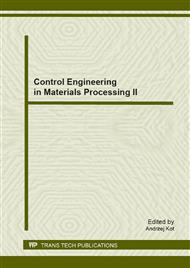p.93
p.102
p.109
p.116
p.125
p.134
p.140
p.148
p.156
LQG Control of the Smart Truss with the Piezoelectric Active Members
Abstract:
A truss is one of the most important parts of different structures applied in several areas of the contemporary industry. One of the most often appeared problems is the undesirable truss vibration activated, for example by the wind. The limitation of the undesired vibration is possible by the increase of the truss dimensions, but it leads to the increasing of the truss mass. The other way of the vibration damping is possible by the introduction of active elements, which generate the control forces acting on selected nodes of the truss. The piezoelectric actuators can be applicable elements to generate such control forces. Special active members are designed in order to introduce the piezoelectric actuators in the truss structure. A project of the control algorithm steering such members is a difficult task, because the truss with active members is MIMO control object. This article presents the results of the simulation research of LQG control system installed in exemplary truss with one, two or three piezoelectric active members. On the basis of the conducted simulation research one can claim that LQG control system could influence the increase of the vibration damping of such piezoelectric smart truss structure, without the increase of the truss mass.
Info:
Periodical:
Pages:
125-133
Citation:
Online since:
September 2013
Authors:
Keywords:
Price:
Сopyright:
© 2014 Trans Tech Publications Ltd. All Rights Reserved
Share:
Citation:


